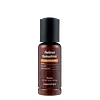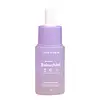What's inside
What's inside
 Key Ingredients
Key Ingredients

 Benefits
Benefits

 Concerns
Concerns

No concerns
 Ingredients Side-by-side
Ingredients Side-by-side

Water
Skin ConditioningButylene Glycol
HumectantGlycerin
Humectant1,2-Hexanediol
Skin ConditioningAluminum Starch Octenylsuccinate
AbsorbentBakuchiol
AntimicrobialHydrolyzed Sodium Hyaluronate
Skin ConditioningSodium Hyaluronate
HumectantHyaluronic Acid
HumectantSodium Hyaluronate Crosspolymer
HumectantPotassium Hyaluronate
Skin ConditioningHydroxypropyltrimonium Hyaluronate
Hydrolyzed Hyaluronic Acid
HumectantSodium Acetylated Hyaluronate
HumectantRosa Damascena Flower Water
MaskingXanthan Gum
EmulsifyingTromethamine
BufferingCaprylic/Capric Triglyceride
MaskingCarbomer
Emulsion StabilisingAcrylates/C10-30 Alkyl Acrylate Crosspolymer
Emulsion StabilisingAdenosine
Skin ConditioningGlyceryl Acrylate/Acrylic Acid Copolymer
HumectantHydrogenated Lecithin
EmulsifyingDisodium EDTA
Methyl Methacrylate Crosspolymer
Retinol
Skin ConditioningInulin Lauryl Carbamate
Emulsion StabilisingHydroxydecyl Ubiquinone
AntioxidantCholesterol
EmollientTocopheryl Acetate
AntioxidantBHT
AntioxidantVigna Radiata Seed Extract
Skin ConditioningAvena Sativa Kernel Extract
AbrasiveWater, Butylene Glycol, Glycerin, 1,2-Hexanediol, Aluminum Starch Octenylsuccinate, Bakuchiol, Hydrolyzed Sodium Hyaluronate, Sodium Hyaluronate, Hyaluronic Acid, Sodium Hyaluronate Crosspolymer, Potassium Hyaluronate, Hydroxypropyltrimonium Hyaluronate, Hydrolyzed Hyaluronic Acid, Sodium Acetylated Hyaluronate, Rosa Damascena Flower Water, Xanthan Gum, Tromethamine, Caprylic/Capric Triglyceride, Carbomer, Acrylates/C10-30 Alkyl Acrylate Crosspolymer, Adenosine, Glyceryl Acrylate/Acrylic Acid Copolymer, Hydrogenated Lecithin, Disodium EDTA, Methyl Methacrylate Crosspolymer, Retinol, Inulin Lauryl Carbamate, Hydroxydecyl Ubiquinone, Cholesterol, Tocopheryl Acetate, BHT, Vigna Radiata Seed Extract, Avena Sativa Kernel Extract
Water
Skin ConditioningPPG-13-Decyltetradeceth-24
EmulsifyingMethylpropanediol
SolventPEG/PPG/Polybutylene Glycol-8/5/3 Glycerin
HumectantButylene Glycol
HumectantLactobionic Acid
BufferingPotassium Azeloyl Diglycinate
Skin ConditioningBakuchiol
AntimicrobialSea Water
HumectantPanthenol
Skin ConditioningAllantoin
Skin ConditioningXanthan Gum
Emulsifying1,2-Hexanediol
Skin ConditioningTriethanolamine
BufferingPhenoxyethanol
PreservativeDisodium EDTA
Chlorphenesin
AntimicrobialCaprylyl Glycol
EmollientWater, PPG-13-Decyltetradeceth-24, Methylpropanediol, PEG/PPG/Polybutylene Glycol-8/5/3 Glycerin, Butylene Glycol, Lactobionic Acid, Potassium Azeloyl Diglycinate, Bakuchiol, Sea Water, Panthenol, Allantoin, Xanthan Gum, 1,2-Hexanediol, Triethanolamine, Phenoxyethanol, Disodium EDTA, Chlorphenesin, Caprylyl Glycol
 Reviews
Reviews

Ingredients Explained
These ingredients are found in both products.
Ingredients higher up in an ingredient list are typically present in a larger amount.
1,2-Hexanediol is a synthetic liquid and another multi-functional powerhouse.
It is a:
- Humectant, drawing moisture into the skin
- Emollient, helping to soften skin
- Solvent, dispersing and stabilizing formulas
- Preservative booster, enhancing the antimicrobial activity of other preservatives
Bakuchiol is a plant-derived antioxidant (it's vegan!). It is often called the replacement for retinol although it is not part of the same family.
It has similar effects as retinol: skin smoothing, reducing discoloration, and preventing wrinkles. It does not cause as much irritation as traditional retinoids.
Bakuchiol works by breaking down free radicals and stimulating collagen production in skin.
Combining bakuchiol with retinol will not have adverse side effects. Studies show using them will just boost the benefits. Bakuchiol is also found to help stabilize retinol.
While bakuchiol does not make the skin more sun sensitive, we recommend wearing SPF on a daily basis.
Read more about traditional retinol
Learn more about BakuchiolButylene Glycol (or BG) is used within cosmetic products for a few different reasons:
Overall, Butylene Glycol is a safe and well-rounded ingredient that works well with other ingredients.
Though this ingredient works well with most skin types, some people with sensitive skin may experience a reaction such as allergic rashes, closed comedones, or itchiness.
Learn more about Butylene GlycolDisodium EDTA plays a role in making products more stable by aiding other preservatives.
It is a chelating agent, meaning it neutralizes metal ions that may be found in a product.
Disodium EDTA is a salt of edetic acid and is found to be safe in cosmetic ingredients.
Learn more about Disodium EDTAWater. It's the most common cosmetic ingredient of all. You'll usually see it at the top of ingredient lists, meaning that it makes up the largest part of the product.
So why is it so popular? Water most often acts as a solvent - this means that it helps dissolve other ingredients into the formulation.
You'll also recognize water as that liquid we all need to stay alive. If you see this, drink a glass of water. Stay hydrated!
Learn more about WaterXanthan gum is used as a stabilizer and thickener within cosmetic products. It helps give products a sticky, thick feeling - preventing them from being too runny.
On the technical side of things, xanthan gum is a polysaccharide - a combination consisting of multiple sugar molecules bonded together.
Xanthan gum is a pretty common and great ingredient. It is a natural, non-toxic, non-irritating ingredient that is also commonly used in food products.
Learn more about Xanthan Gum